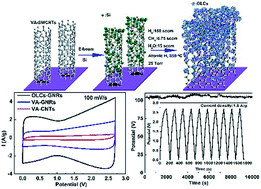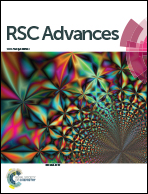Growth of carbon composites by grafting on pregrown vertically aligned single-walled carbon nanotube arrays and their use in high power supercapacitors†
Abstract
Carbon composite materials consisting of onion-like carbons (OLCs) and vertically aligned graphene nanoribbons (VA-GNRs) have been efficiently prepared by an atomic hydrogen treatment. SiC is employed as the seed for growing nanodiamonds, which serve as precursors and convert into OLCs. The obtained OLCs are quasi-spherical in shape with closed concentric graphite shells without a core. The original vertical structural integrity and alignment of VA-GNRs is well preserved, and the OLCs remain highly porous. The electrochemical measurements show that the OLC–GNRs composite exhibits higher capacitive properties than the original vertically aligned single walled carbon nanotubes (VA-SWCNTs) carpet and VA-GNRs. This composite nanostructure demonstrates a high performance in maximum specific energy (36.4 Wh kg−1), specific power (270.2 kW kg−1), and cycle stability (no drop after 10 000 cycles). The superior electrochemical performance of the OLCs–GNRs composite electrode can be attributed to the higher specific surface area of the additional porous OLCs, and the vertical alignment of the conductive paths of VA-GNRs. All demonstrate that atomic hydrogen treatment is an attractive approach to fabricate electrodes for supercapacitors with high power and energy density.


 Please wait while we load your content...
Please wait while we load your content...